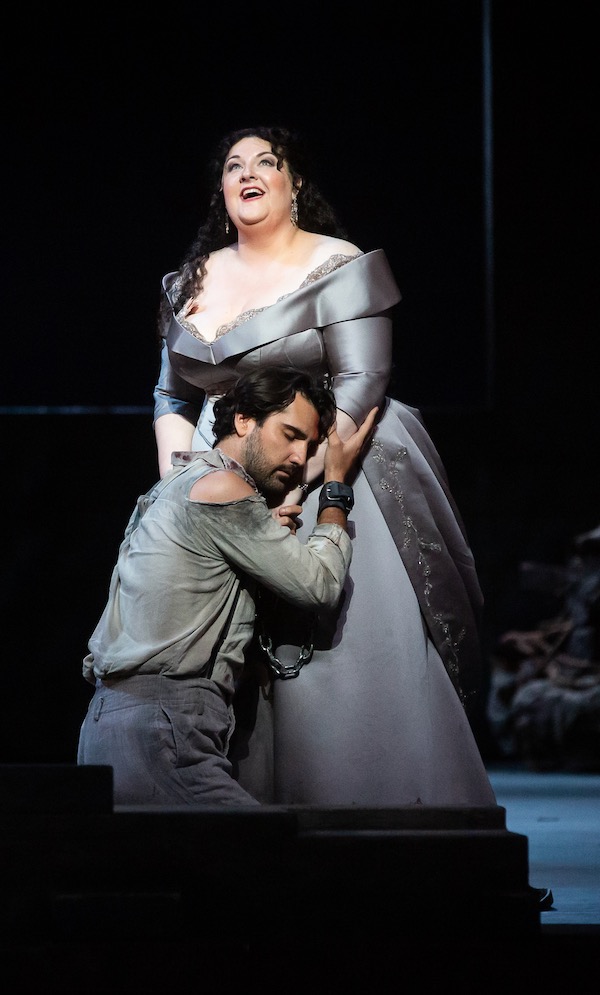Wilson makes HGO’s “Tosca” a blazing vocal feast

Tosca has long since won out over a critic’s put-down of it as a “shabby little shocker.” But the infamous comment does, at least, point up the fact that Puccini’s musical melodrama deals out operatic thrills and chills that have few parallels.
Houston Grand Opera treated all that to salvo after salvo of high-voltage, go-for-it singing Friday at Wortham Theater Center.
The more distraught Tosca grew, pursued by the lust-driven police chief Scarpia, the more soprano Tamara Wilson let fly with the blazing tones that she unleashed so commandingly in last season’s HGO production of Puccini’s Turandot.
Tenor Jonathan Tetelman—making his company debut as Tosca’s ill-fated lover, Cavaradossi—was every bit Wilson’s match in vocal impact, filling the hall with gleaming and vibrant sound. And baritone Rod Gilfry, playing Scarpia, completed the theatrical troika with his dark-hued, voluminous threats and outbursts.
Puccini didn’t call on Tosca to be frantic from the outset, of course. Her love for Cavaradossi is front and center at first, and Wilson put that across through the warmth and poise she brought the pair’s love duet.
But when Tosca, with her hair-trigger jealousy, cried out the name of her imagined rival, Wilson’s vocal fire began to emerge. And it flashed all the more powerfully when Tosca faced Scarpia’s pursuit.
Wilson’s surging, full-throated singing in Act 2 —undaunted by altitude—told the story in the most riveting way. In the midst of the furor, the soprano’s “Vissi d’arte” gave just as compelling a view of the emotions roiling inside Tosca. At the aria’s beginning, Wilson reined her voice in, emphasizing the vulnerability Puccini’s lyricism conveys. Then her singing swelled as Tosca’s desperation bubbled up again.
The contrasting fragility and outcry continued through the whole aria, keeping it vivid and fresh, for all its familiarity.
In the opera’s final minutes, Wilson brought out yet another vocal color. As Tosca bantered with Cavaradossi about his playing dead after his—so they think—fake execution, Wilson’s lightness injected a note of levity that made the final calamity all the more wrenching.
Considering how powerfully Tetelman’s voice rang out in the cavernous Jones Hall last fall, when he joined the Houston Symphony as tenor soloist in Verdi’s Requiem, it seemed a safe bet that he’d make an even greater impact in the more congenial Wortham.
Sure enough, in the opera’s first minutes, Tetelman filled the hall with gleaming melody via Cavaradossi’s “Recondita armonia.” The big, ardent sound kept pouring out in Cavaradossi’s scene with Tosca.
In Act 2, Tetelman reveled in Cavaradossi’s cries of “Vittoria!”—drawing them out to exude defiance. But by this point, his singing had raised one question: Where was the delicacy Tetelman had brought to parts of Verdi’s Requiem? Even in the duet with Tosca, his Cavaradossi hadn’t been one for vocal caresses.
The last act, as Cavaradossi awaited the firing squad, finally brought the change. At the outset, Tetelman’s half-tones captured the doomed man’s resignation. And when he launched into the melody of “E lucevan le stelle,” his voice grew quieter and quieter as it soared, giving Puccini’s music a poetry and intimacy beyond anything else in the entire performance.
For all the bad-guy impact that Gilfry’s weighty tone brought his Scarpia, Gilfry at times sounded pressed in Act 1, sometimes pushing his voice off pitch. But he hit his stride in Act 2.
Here Gilfry turned to quiet, insidious tones that carried their own threatening aura, playing off against the force of his outbursts. Gilfry’s Scarpia sneered as he made fun of lovers’ moonlight escapades, and he brought a butter-wouldn’t-melt-in-his-mouth chill to the moments when he pretended to play nice. In a final, non-singing touch of theatricality, Gilfry’s dying Scarpia let out a death rattle as he expired—perhaps answering Tosca’s question about whether he’s choking on his own blood.
Tenor Matthew Grills gave Spoletta, Scarpia’s main henchman, a threatening air of his own—cool, collected and unfeeling. As the Sacristan, bass-baritone Nicholas Newton sang with gusto and cut a jovial figure. Bass Daniel Noyola gave the runaway prisoner Angelotti a fitting air of desperation.
For all the power and ferocity that the HGO Orchestra, conducted by Benjamin Manis, put into the score’s explosions, it was even more telling in the quiet scenes. From the glow of the strings in quiet moments to the silkiness of the clarinet solo launching “E lucevan le stelle,” the group savored Puccini’s tone-painting and glow.
Stage director John Caird here and there found ways to add a new frisson to the tale’s histrionics.
After Scarpia ordered a henchman to open the door to the torture chamber where Cavaradossi was being interrogated, the impatient Scarpia went ahead and kicked it open himself. When two stabs in the back didn’t finished Scarpia off, Tosca reached around and slit his throat. After he expired, she stuffed the knife in her boot.
Designer Bunny Christie’s unit set was a big, boxy room that lent the whole story an air of confinement—broken only by an opening at the rear in Act 3.
Christie’s costumes changed the time period to the late 19th or early 20th century, to judge by Tosca’s billowing gown and the men’s frock coats. When Scarpia was in his full suit, he could’ve passed for a sober American preacher of the same era.
Tosca will be repeated at 2:30 p.m. Sunday and 7:30 p.m. April 29 and May 2 and 5 at Wortham Theater Center. houstongrandopera.org